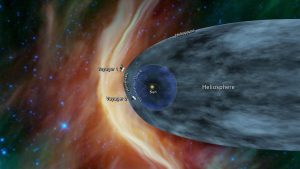Voyager 2 May Soon Be Joining Its Twin in Interstellar Space
October 29, 2018

In 2012, Voyager 1, one of a pair of deep-space probes launched in 1977, crossed into a part of space no other spacecraft had ever seen: the interstellar medium. At over 11 billion miles from the Sun, crucial changes were detected in the data Voyager 1 was sending back to Earth – key observations to show that Voyager 1 was entering interstellar space. The planets in the solar system are surrounded by an outpouring of material from the Sun, called the solar wind, which creates a giant bubble called the heliosphere. Eventually, the solar wind peters out, held back by the wind coming from other stars – and this is the boundary that Voyager 1 crossed. High energy particles are known to originate outside our heliosphere and don’t easily penetrate. Observation of an increase in flux of such particles is a strong indication that the boundary has been crossed. Data from the Cosmic Ray Subsystem (CRS) instrument on the spacecraft showed this increase at Voyager 1 and the CRS on Voyager 2 is now seeing the same effect. The image shown an artist’s drawing of the respective locations of the spacecraft. A SESDA staff member is responsible for processing the CRS data and assisting with data analysis. [Excerpted from https://blogs.nasa.gov/sunspot/2018/10/24/voyager-2-may-soon-be-joining-its-twin-in-interstellar-space/]
Comments are closed.
-
Article Details:
Posted on: Monday, October 29th, 2018
Posted in: News, SESDA News
Subscribe: RSS 2.0
Comments: No Responses -
Recent News:
